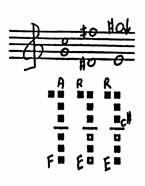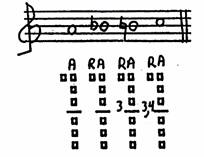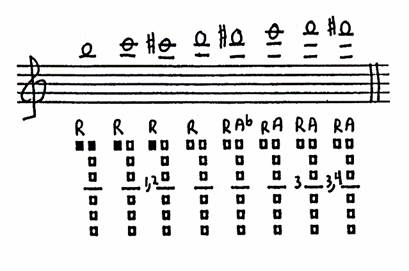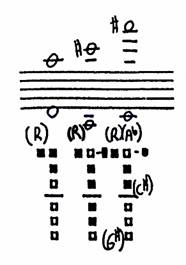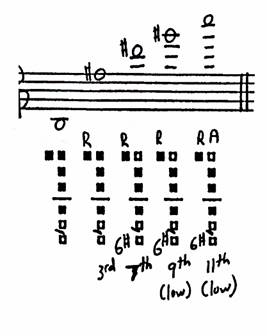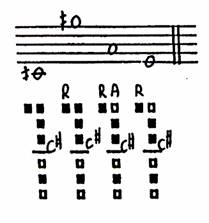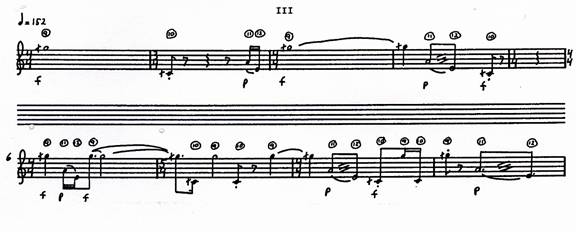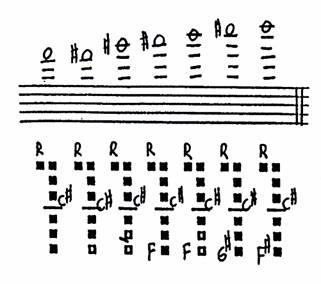| The Clarinet of the Twenty-First Century - E. Michael Richards |
CHAPTER 2 - Single Sounds
Alternate Fingerings (continued)
A chart of other fingerings (B3 - G5) suitable for rapid alternation with the regular fingering of the same pitch, follows (Table #1). Those which can not be alternated at a rapid speed have been labeled nf (not fast). The intonation of these pitches is extremely close to the regular fingering; only minor adjustments of the type made in normal tuning while playing may be necessary. Those pitches which may exhibit noticeable tuning discrepancies have been labeled (s. low = slightly low, etc.) 9 ; pitches that are a bit more resistant than regular fingerings are designated "resist."
Table #1 (click on measure to hear mp3)
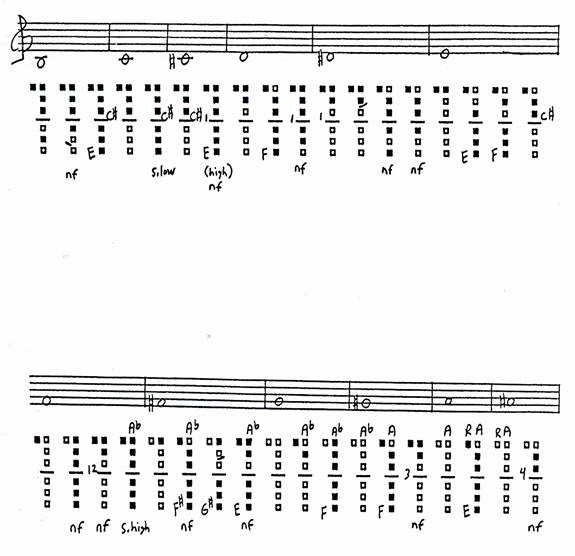
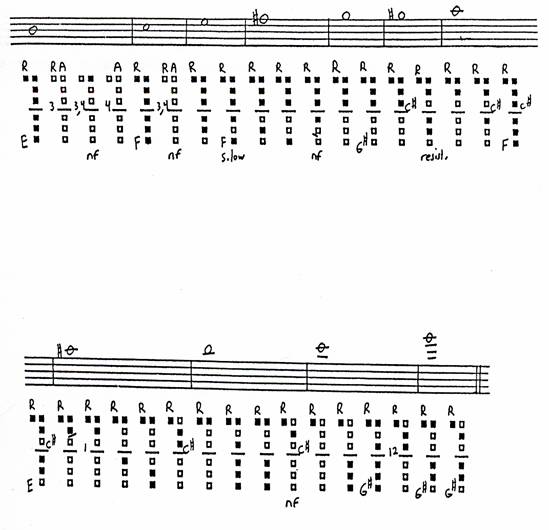
Alternate fingerings of contrasting timbre and dynamic capabilities may also be extracted from diads (multiple sounds consisting of two pitches). The lowest pitches from these fingerings are especially dull sounding and only playable at ppp-pp dynamic levels. The reader is referred to Chapter III for other similar sounding alternate fingerings; all multiphonics that are possible to begin with the bottom note only, will work (Table #2).
Table #2 (click on measure to hear mp3)
The lower register "break" (B-flat4 - B4) of the clarinet has also, historically, been a cause of problems for the performer.10 Not only has timbral homogeneity been difficult to achieve, but the movement of so many fingers from one pitch to the next has also limited the possibilities for a smooth legato. Alternate fingerings for the lower clarion register do exist, and often can be employed quite successfully to extend the throat register (Example #10). These fingerings are likely to be somewhat unfamiliar to many clarinetists (since they utilize the rarely employed upper trill keys which are played by the side of the stretched first finger of the right hand), so care should be taken if they are to be approached by leap.
Example #25 (click on music to hear mp3)
Legato movement over the "break" between the clarion and altissimo registers is somewhat easier to negotiate than the lower break. A set of alternate fingerings do exist, however, that actually function by overblowing the alternate fingerings just described for the lower clarion register. The timbre of these pitches becomes brighter and thinner as they become higher (Example #33). These alternates may be difficult to produce in an isolated context softer than mf, and must be attacked in a fairly strong manner to insure stability (especially the highest three pitches).
Example #33 (click on music to hear mp3)
An abundance of alternate fingerings exist for pitches in the altissimo register. Paul Drushler has very clearly described the acoustical link between basic fingerings and registers of the clarinet (Example #34a). Third partials (clarion register) are produced by depressing the register key (thus opening the register hole). Fifth partials (C-sharp5 - A-sharp6) are produced by lifting the first finger of the left hand, in addition to the register key. This permits the LH1 tone-hole to act as a vent. Seventh partials, and higher, are generally produced by depressing the G-sharp key in addition to the others mentioned (in the chart of altissimo fingerings presented in this chapter, the F-sharp key, as well as other vents, seems to be equally represented). The general outline of this formula is followed in the following example (Example #34b). It is important to note that many fifth partials also require the G-sharp key, and that other vents (A key) are utilized for pitches derived from the highest partials. In addition, the highest pitches often stem from "out of tune" partials of unrelated fundamentals. It is clear that the desirable method for developing fingerings consists of starting with a fundamental, selecting vents, and making final alterations by opening and/or closing various tone holes. According to Drushler, "variations in pitch, timbre and stability for specific altissimo notes can be discovered by experimenting with modifications of basic fingerings." 11
Example #34a (click on music to hear mp3)
#34b (click on music to hear mp3)
The limited finger movement required between the five pitches in Example #35a can be utilized by composers in rapid musical passages. Drake Mabry has written for a "composite fingering" in the third movement of Street Cries for solo clarinet (Example #35b). This particular fingering not only permits swift leaps in register without much trouble, but also provides a dramatic contrast of timbres.
Example #35a (click on music to hear mp3)
#35b (click on music to hear mp3)
Some other possible composite fingerings are included below (Table #4).
Table #4 (click on music to hear mp3)
The American clarinetist Henry Gulick writes of classifications for altissimo register pitches.12 These categories deserve mention, as well as others, in order to understand timbre and resistance characteristics of altissimo fingerings. One classification that is widely employed by professional clarinetists is what Gulick calls "long fingerings." In long fingerings, the first finger of the left-hand remains on the tone-hole; a vent exists further down the clarinet body. As a result, long fingerings require overblowing of lower pitches. The longer tube length that is in play produces thicker, darker timbres that are generally more secure at loud dynamic levels (Example #36).
Example #36 (click on music to hear mp3)
for information on how to see/hear more alternate fingerings, click here
|
||
